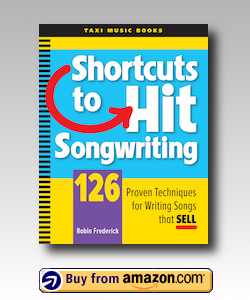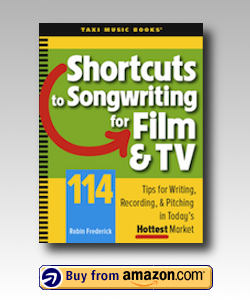‣ Study Today's Hit Songs!
You can easily keep up to date with the successful techniques of today's top songwriters by studying current hits. It's an essential skill if you want to write songs that are competitive and expressive, and it's a lot of fun! Hit songs can be full of surprises and can inspire you to try new ideas in your own songs.
For those of you who have my books - "Shortcuts to Hit Songwriting" and 'Shortcuts to Songwriting for Film & TV" - I've referred to Shortcuts that can tell you more about the ideas discussed here. Both books are available at Amazon.com.
"POISON AND WINE" - THE CIVIL WARS(Writers: Joy Williams & John Paul White)
* * * * * * * * * * * * * * * |
"SOMEBODY THAT I USED TO KNOW" - GOTYE(Writer: Walter De Backer, aka Gotye)
* * * * * * * * * * * * * * * |
"THESE DAYS" - FOO FIGHTERS(Writer: David Grohl)
* * * * * * * * * * * * * * * |
SONGS BY ADELE
* * * * * * * * * * * * * * * |
"TATTOOS ON THIS TOWN" - JASON ALDEAN(Michael Dulaney, Wendell Mobley, Neil Thrasher)
This is the fourth hit single from Jason Aldean's album My Kinda Party. This is a great album to study if you're looking at the Country market! Aldean is not a songwriter-all of the tracks were chosen for their strong lyrics and melodies and their potential to compete on today's Country radio. While I don't always think Aldean's vocals hit the mark, he sure knows how to pick a song! |
"DYNAMITE" - TAIO CRUZ(Levin/McKee/Martin/Adetayo/Onile/Gottwald)
GENRE (What is a genre?) |
"WHEN YOU LOVED ME" by RICHARD MARX(Richard Marx/Matt Scannell)
I thought it would be interesting to take a look at the new single, "When You Loved Me," from 1980s megastar Richard Marx and compare it with the huge hits that propelled him to million seller status a couple decades ago. How will a successful singer-songwriter of 25 years ago adapt to the current music market? What can YOU do to update some of your older songs?
|
FILM & TV SONGS by THE WEEPIES(Deb Talan/Steve Tannen)
You might not have heard of a duo called the Weepies but they've had dozens of placements in today's hottest TV dramas. Shows like Life Unexpected, Gossip Girl, One Tree Hill, Brothers and Sisters, and Greek have all used their whimsical, simply-produced, acoustic-based songs. Why does The Weepies' music have such strong appeal for music supervisors? Could you add some of that appeal to your own songs? Let's take a look. |
"GRENADE" - BRUNO MARS(Wyatt/Levine/Lawrence/Mars/Kelly/Brown)
Here's a Pop/R&B gem with an irresistibly hummable melody and a raw, emotionally over-the-top lyric. It's also an interesting blend of styles: a contemporary, driving melody with classic R&B elements in the chorus and singer-songwriter style lyrics. |
"KING OF ANYTHING" - SARA BAREILLES
This song had a long run on the AC (Adult Contemporary) radio airplay charts. It has also been used in two TV series - The Medium and Life Unexpected. It works well in both markets! |
"SMILE" - UNCLE KRACKER(Jeremy Bose, Blair Daly, J Harding, Matthew Shafer)
I really love the feel, the energy, and the emotion of this song. I guess a lot of other people do, too, because it's a platinum-selling single that's been at the top of both the Top 40 charts and the Country charts. And I'll bet you that music supervisors are falling all over themselves trying to get this song (or something like it) into films and TV shows. This song was a bit of a sleeper when it was first released in 2009, but came back with a roar in 2010. Just goes to show: You can't keep a good song down! |
"HANDS TIED" - TONI BRAXTON(Heather Bright, Warren Felder, and Harvey Mason, Jr.)
STRUCTURE |
"THE HOUSE THAT BUILT ME" - MIRANDA LAMBERT(Tom Douglas and Allen Shamblin)
There are many reasons why this is an unlikely hit song and yet it found it's way to the top spot on the Country charts and gives no sign of leaving anytime soon. The song itself sounds more like an album cut than a hit; while the chorus has a beautiful payoff line at the end, it lacks the huge hooks and big emotional release that usually drives a song to #1. So let's see what it has that makes people want to hear it over and over. |
"WHY DON'T WE JUST DANCE" - JOSH TURNER(Singleton / Beavers / Brown)
Josh was looking for Country hits for his new album and found this one through a Nashville publisher. I know a lot of songwriters who pitched for this so it's interesting to hear what the artist finally chose. |
More hit songs...
Over her 35 years in the music industry, Robin Frederick has written more than 500 songs for television, records, theater, and audio products. She is a former Director of A&R for Rhino Records , Executive Producer of 60 albums, and the author of "Shortcuts to Hit Songwriting." Robin currently oversees the A&R Team for TAXI, the world's leading independent A&R company.
Robin's books are used to teach songwriting at top universities and schools in the U.S. They're fun to read and filled with practical, real world information. Buy them at Amazon.com...
Shortcuts to Hit Songwriting
Shortcuts to Songwriting for Film & TV






